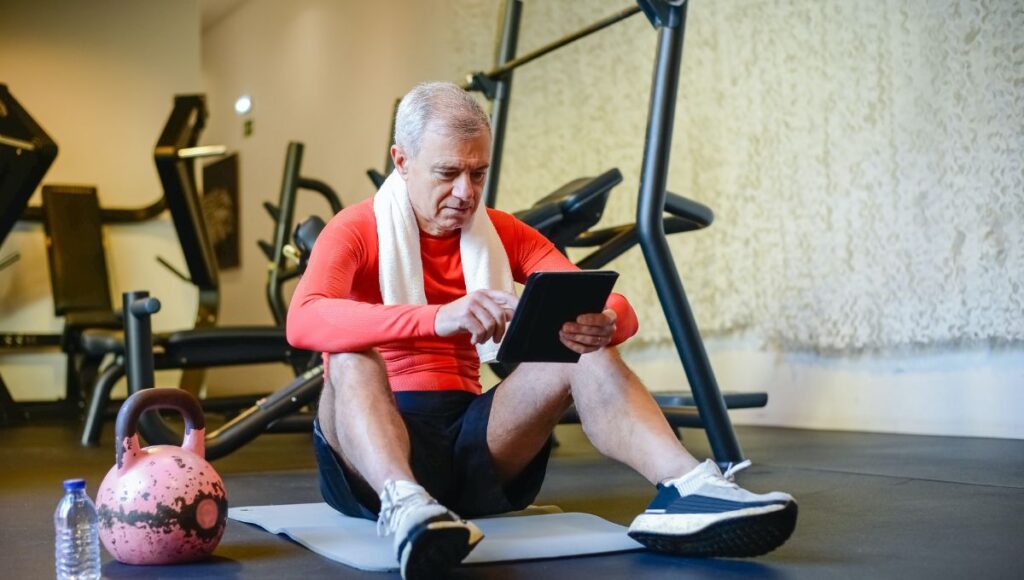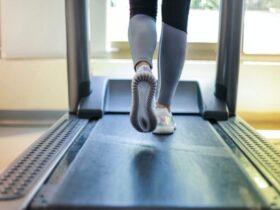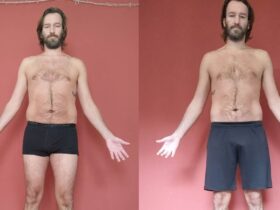Do you know the best exercises for great health and a longer life? Could it be running, swimming, weightlifting, jump rope? You will find out more info below.
In a recent discussion between renowned neuroscientist Andrew Huberman and longevity expert Peter Attia, the conversation delved into the key factors influencing lifespan and strategies for promoting longevity. The duo explored various aspects, including the impact of smoking, differences between cannabis and nicotine, and the prime movers for longevity. In this article, we will dissect the insightful conversation and uncover the secrets to living a longer and healthier life.
Andrew Huberman, Ph.D., is a neuroscientist and tenured Professor in the Department of Neurobiology at the Stanford University School of Medicine. He has a YouTube channel named Huberman Lab with over 3 million subscribers where he talks everything about the brain and, often enough, how to improve one’s health and fitness with it.
Peter Attia is a prominent figure in longevity, health optimization, and medicine. Through his medical practice and involvement in research initiatives, Attia focuses on extending lifespan and improving quality of life. A thought leader in health and wellness, he communicates complex medical concepts effectively, emphasizing the significance of nutrition, exercise, and lifestyle choices in optimizing health and longevity.
So let’s dig deep and find out what they talked about when the conversation revolved around the best exercises for great health and a longer life.
Related: 9 Simple Tips to Live Longer
The Best Exercises for Great Health and a Longer Life
Huberman and Attia kicked off their discussion by highlighting the well-established risks of smoking, emphasizing that it increases the risk of all-cause mortality (ACM) by approximately 40%. Attia clarified that this doesn’t necessarily mean a 40% reduction in lifespan but rather a 40% greater risk of death at any given time compared to non-smokers. The duo agreed on the importance of distinguishing between cannabis and nicotine when discussing smoking’s impact on longevity.
Other Health Risks and Solutions:
Moving beyond smoking, Huberman and Attia delved into other factors influencing ACM, such as high blood pressure and end-stage kidney disease. They revealed that high blood pressure contributes to a 20-25% increase in ACM, while end-stage kidney disease, often linked to uncontrolled hypertension and type 2 diabetes, sees a staggering 175% increase.
The Role of Strength and Muscle Mass:
Shifting the focus to positive interventions, the conversation turned to the importance of strength and muscle mass. Attia presented data comparing low muscle mass individuals to high muscle mass individuals, showing a significant 3x improvement in ACM for those with greater muscle mass. He noted that strength, rather than just muscle mass, plays a crucial role, with a hazard ratio of 3.5x indicating a 250% greater risk for those with low strength.
Cardiorespiratory fitness emerged as a powerful determinant of longevity.
In the conversation between Andrew Huberman and Peter Attia, they discuss VO2 max as a crucial metric for cardiovascular fitness. Attia mentions that individuals can estimate their VO2 max by looking at charts available online, which typically involve inputting data related to their activity, such as running, biking, or rowing.
 Source: Todd Quackenbush on Unsplash
Source: Todd Quackenbush on UnsplashHow Running Once a Week Changes Your Body
Attia suggests that achieving specific milestones in activities like running can provide an indication of one’s VO2 max. “At least to the 75th percentile,” he says. For instance, he mentions that running a mile within a certain time frame can be a good indicator. Attia also refers to charts available on his podcast that showcase VO2 max values based on age and sex.
It’s important to note that VO2 max is a measure of the maximum amount of oxygen a person can use during intense exercise and is often considered a key indicator of cardiovascular fitness. The specific benchmarks for VO2 max can vary, but generally, higher values are associated with better cardiovascular health and endurance.
Attia discussed the profound impact of cardiorespiratory fitness on ACM, highlighting a 2x difference between individuals in the bottom 25% and those at the 50th to 75th percentile. Comparing the bottom 25% to the top 2.5%, a remarkable 5x difference in ACM was observed, indicating a 400% reduction in mortality risk for those in the elite category.
What Are the Minimum Steps You Should Walk Every Day for Health Benefits (Not 10K)
Strategies for Improvement:
Huberman and Attia concluded by discussing actionable steps for enhancing longevity. Attia proposed “Attia’s rule,” suggesting that discussions about supplements and nutrition should only follow once individuals have achieved certain fitness benchmarks. The benchmarks included metrics like dead hangs, wall sits, and cardiovascular endurance, providing a tangible roadmap for individuals aspiring to live longer and healthier lives.
In the context of “Attia’s Rule,” while the exact duration or intensity may vary based on factors such as age and gender, Attia suggests the following benchmarks:
- Dead Hangs:
- Goal: Individuals should aim to perform dead hangs for a specific duration.
- Example: Attia mentions a goal of a minute or more for a dead hang.
- Wall Sits (or Air Squats):
- Goal: Performing a wall sit or air squat at a specific degree for a defined duration.
- Example: Two minutes for a wall sit or air squat at 90 degrees may be a standard benchmark.
- Cardiovascular Endurance:
- Goal: Achieving a certain level of cardiovascular fitness, often measured by running a mile within a specific time frame.
- Example: Running a mile in seven minutes or less may be indicative of the desired cardiovascular fitness level.

What Happens to Your Body When You Hang Every Day?
These benchmarks serve as prerequisites, indicating that individuals should meet these fitness goals before delving into in-depth discussions about nutritional strategies and supplementation. The specific duration or intensity can be adjusted based on individual factors such as age, gender, and overall fitness level. Attia’s emphasis is on establishing a foundational level of physical fitness before exploring finer details of dietary interventions.
The conversation between Andrew Huberman and Peter Attia unveiled valuable insights into the factors influencing longevity and practical strategies for promoting a healthier and longer life. From the risks of smoking to the positive impact of strength and cardiorespiratory fitness, their discussion serves as a roadmap for individuals seeking to optimize their health and extend their lifespan.
It might be easier and better for you to listen to their entire conversation, which you can do in the video below.
How to Do HIIT Cardio to Get To 10% Body Fat
The Only 8 Bodyweight Exercises You Need to Build Muscle Fast
Why Is It Important to Maintain a Healthy Life Through Fitness
Maintaining a healthy life with fitness is crucial for a multitude of reasons that span physical, mental, and emotional well-being. Here are several key reasons why prioritizing fitness is important:
- Physical Health:
- Disease Prevention: Regular physical activity is linked to a reduced risk of chronic diseases such as heart disease, diabetes, and certain cancers.
- Weight Management: Fitness contributes to weight control, aiding in the prevention of obesity and associated health issues.
- Cardiovascular Health:
- Heart Health: Exercise strengthens the heart, improves blood circulation, and helps maintain healthy blood pressure, reducing the risk of cardiovascular diseases.
- Mental Health:
- Stress Reduction: Physical activity is a natural stress reliever, helping to reduce cortisol levels and improve overall mood.
- Cognitive Function: Regular exercise is associated with improved cognitive function, memory, and a reduced risk of cognitive decline.
- Emotional Well-Being:
- Mood Enhancement: Physical activity stimulates the release of endorphins, neurotransmitters that contribute to feelings of happiness and well-being.
- Better Sleep: Regular exercise can improve the quality of sleep, promoting overall mental and physical recovery.
- Enhanced Quality of Life:
- Increased Energy: Fitness contributes to higher energy levels, making daily activities more manageable and enjoyable.
- Improved Mobility and Flexibility: Regular movement and exercise enhance flexibility, coordination, and overall mobility, ensuring a more active lifestyle.
- Longevity:
- Life Expectancy: Leading a healthy and active life is linked to increased life expectancy, promoting a longer, more fulfilling life.
- Social Benefits:
- Community Engagement: Participating in fitness activities often involves social interaction, fostering a sense of community and support.
- Team Building: Group fitness activities can strengthen social bonds, contributing to a sense of belonging.
- Disease Management:
- Chronic Disease Support: For individuals managing chronic conditions, exercise can play a vital role in symptom management and overall health improvement.
- Boosted Immune System:
- Enhanced Immunity: Regular exercise contributes to a stronger immune system, reducing the likelihood of illness.
- Stress Resilience:
- Coping Mechanism: Physical activity provides an outlet for stress, helping individuals build resilience and cope with life’s challenges.
In essence, maintaining a healthy life with fitness is a holistic approach that not only addresses physical health but also contributes significantly to mental and emotional well-being. It is a powerful tool for preventing diseases, enhancing longevity, and improving the overall quality of life.
Stop Sitting, Start Stretching: 5 Tips To Improve Flexibility
Why You’re Always Tired and How to Fix It
Source link: https://www.boxrox.com/the-best-exercises-for-great-health-and-a-longer-life/ by Robert Born at www.boxrox.com






